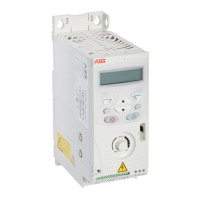Actual signals and parameters
Parameters in the Long parameter mode
Activates/deactivates the Flux optimisation function. Flux optimisation
reduces the total energy consumption and motor noise level when the drive
operates below the nominal load. The total efficiency (motor and the drive)
can be improved by 1% to 10%, depending on the load torque and speed.
The disadvantage of this function is that the dynamic performance of the
drive is weakened.
Defines the output voltage boost at zero speed (IR compensation). The
function is useful in applications with a high break-away torque. To prevent
overheating, set IR compensation voltage as low as possible.
The figure below illustrates the IR compensation.
Motor
A = IR compensated
voltage
B = No compensation
A
Typical IR compensation values:
2603
f (Hz)
B
2604
Defines the frequency at which the IR compensation is 0 V. See the figure for
parameter 2603 IR COMP VOLT.
Value in percent of the motor frequency
Selects the voltage to frequency (U/f) ratio below the field weakening point.
Linear ratio for constant torque applications
Squared ratio for centrifugal pump and fan applications. With squared U/f
ratio the noise level is lower for most operating frequencies.
Defines the switching frequency of the drive. Higher switching frequency
results in lower acoustic noise. See also parameter 2607 SWITCH FREQ
CTRL and section Switching frequency derating, I2N on page 139.
In multimotor systems, do not change the switching frequency from the
default value.

